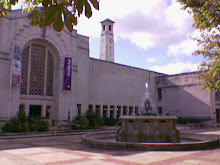7.4.12 (Easter Saturday)
We did not have an Easter theme, but our topic today was Pictures. We began with Howard Nemerov’s ‘Vermeer’. Initially pronounced unsatisfactory as a poem, for its inclusion of some banal vocabulary, discussion ranged from approval to disdain, but some allowance was made for the possibility that Nemerov had succeeded in describing the inability of words to truly capture what the eye can see.
U.A. Fanthorpe’s compact little ‘Portraits of Tudor Statesmen’ was approved for its representation of anxiety. Stephen Dobyns’s ‘The Street’, written as an evocation of Balthus 1933 painting of the same name was more difficult to deal with, as the painting (reproduced in photocopy) was thought to be influenced by Surrealism. Some of us were disconcerted by the baby, others by the one-dimensional workman. Sylvia Plath’s ‘The Disquieting Muses’ also came with a print of the picture by George Chirico that inspired it.
We were on easier ground with Anne Stevenson’s ‘Who’s Joking with the Photographer?’ We all enjoyed the honest and finely rendered impression of a woman confronting depictions of her aging face.
Norman Nicholson’s ‘Thomas Gray in Patterdale’ was not about a picture but about the 18thC framing of landscape to make a picture, and its ‘Wordsworth-esque’ effect on the viewer when not constrained by ideas of control.
We ended with further controversy with another Stephen Dobyn’s poem ‘Where We Are’. Not ostensibly about a picture, it takes Bede’s famous simile for the Christian in the world as like a sparrow that flies briefly through the warmth and safety of the feasting hall and returns out into the storm.
After an afternoon packed with intense discussion, we may look forward to next time, when we have Free Choice.
We did not have an Easter theme, but our topic today was Pictures. We began with Howard Nemerov’s ‘Vermeer’. Initially pronounced unsatisfactory as a poem, for its inclusion of some banal vocabulary, discussion ranged from approval to disdain, but some allowance was made for the possibility that Nemerov had succeeded in describing the inability of words to truly capture what the eye can see.
U.A. Fanthorpe’s compact little ‘Portraits of Tudor Statesmen’ was approved for its representation of anxiety. Stephen Dobyns’s ‘The Street’, written as an evocation of Balthus 1933 painting of the same name was more difficult to deal with, as the painting (reproduced in photocopy) was thought to be influenced by Surrealism. Some of us were disconcerted by the baby, others by the one-dimensional workman. Sylvia Plath’s ‘The Disquieting Muses’ also came with a print of the picture by George Chirico that inspired it.
We were on easier ground with Anne Stevenson’s ‘Who’s Joking with the Photographer?’ We all enjoyed the honest and finely rendered impression of a woman confronting depictions of her aging face.
Norman Nicholson’s ‘Thomas Gray in Patterdale’ was not about a picture but about the 18thC framing of landscape to make a picture, and its ‘Wordsworth-esque’ effect on the viewer when not constrained by ideas of control.
We ended with further controversy with another Stephen Dobyn’s poem ‘Where We Are’. Not ostensibly about a picture, it takes Bede’s famous simile for the Christian in the world as like a sparrow that flies briefly through the warmth and safety of the feasting hall and returns out into the storm.
After an afternoon packed with intense discussion, we may look forward to next time, when we have Free Choice.

